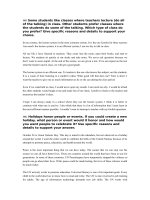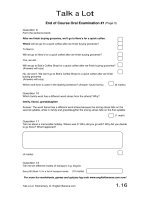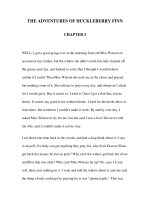Education english 3 pptx
Bạn đang xem bản rút gọn của tài liệu. Xem và tải ngay bản đầy đủ của tài liệu tại đây (69.34 KB, 6 trang )
CHAPTER 5 • LearningExpress Skill Builders
104
______ 4. Some villagers had never seen an automobile. Only knowing bicycles as a means of transportation.
_____________________________________________________________________________
_____________________________________________________________________________
______ 5. Environmentalists fear that once the Alaska oil fields are opened for exploration, wilderness will be
destroyed. With no guarantees that our energy crisis will have been helped in the process.
_____________________________________________________________________________
_____________________________________________________________________________
______ 6. Recent census figures indicate that there has been a dramatic increase in the number of men who
are single parenting their children, the mothers gave up custody during the divorce proceedings.
_____________________________________________________________________________
_____________________________________________________________________________
______ 7. Human cloning is just years if not months away do we fully understand the social consequences of
our research?
_____________________________________________________________________________
_____________________________________________________________________________
______ 8. Testing cosmetics by using helpless animals is cruel, there should be laws to protect against such abuse.
_____________________________________________________________________________
_____________________________________________________________________________
______ 9. Weather maps, graphs, charts, tables. All are confusing to read.
_____________________________________________________________________________
_____________________________________________________________________________
______ 10. Hurricanes are dangerous storms costing thousands of dollars to homeowners in repair costs each
year, Congress should pass more laws to help citizens in crises such as these.
_____________________________________________________________________________
_____________________________________________________________________________
–BASIC SKILLS FOR COLLEGE–
LearningExpress Skill Builders • CHAPTER 5
105
HOMONYM ERRORS
Some of the sentences below are correct and some have
homonym errors. The homonym in each sentence is
und
erlined. Remember that homonyms are words that
sound alike but are spelled differently and mean dif-
ferent things. Put a C to the left of the correct sentence
and an X next to the incorrect sentence. If the homonym
is incorrect, write it correctly on the line that follows
the sentence.
______ 1. The aff
ects of the tornadoes can be dev-
astating.
________________________________
______ 2. The p
rincipal of the mortgage remains
almost constant as the interest is paid off.
________________________________
______ 3. A college education has it
’s rewards, best
of which is higher earning capacity.
________________________________
______ 4. Why the
re are so few candidates to replace
the president is a mystery to everyone.
________________________________
______ 5. He explained that he had been e
xcepted
at two other schools.
________________________________
______ 6. It was the pat
ience that worried the most
about the hospital blackout.
________________________________
______ 7. The Gobi d
esert is in Africa.
________________________________
______ 8. The angle of d
escent determines the air
speed.
________________________________
______ 9. Inclement w
hether conditions caused our
delay.
________________________________
______ 10. He had been d
yeing
for months, and when
the end came he was grateful.
________________________________
SEMICOLONS
The following paragraph has errors in semicolons. The
sentences have been numbered for you. Number down
1–10 on a separate sheet of paper and mark a C if the
sentence is correct. If it is incorrect, identify the error
and rewrite the sentence correctly. Remember that
there may be more than one way to correct a sentence
error.
(1) In an editorial that ran during the Clinton
scandal, the New York Times called for censure
rather than impeachment. (2) Although it
never did explain why censure was better than
impeachment; in fact, the editorial gave many
reasons why censure was good; but it never
addressed why impeachment was bad. (3) One
can only assume that if censure was preferable
one reason had to be because impeachment
would have seriously harmed the reputation of
the United States abroad; weakening our
position as a world leader. (4) Who in the
world would care if the President of the United
States engaged in, “ deceitful and dishonest
conduct that was grossly inconsistent with his
constitutional obligations and sacred duty” is a
–PRACTICE TESTS IN GRAMMAR, WRITING, AND READING COMPREHENSION–
CHAPTER 5 • LearningExpress Skill Builders
106
mystery to most Americans; however, if the
New York Times implied it, it must be true.
(5) What everyone should have been more
concerned with was that the actions of the
former president landed many of his friends
and colleagues in court or in jail; costing them
millions in legal fees. (6) This may not have
been grounds for impeachment; censure,
however, was too mild a punishment. (7) What
the New York Times should have called for was
that the president and his wife would have
been held responsible for all legal costs
incurred by anyone brought to court because
of their actions; with no limit set on the dollar
amount. (8) As it is, the former president
walked out of office unscathed; the first lady
was elected to the Senate! (9) So much for the
New York Times and censure. (10) The Clintons
left office both uncensured and unimpeached;
their reputations only slightly blemished.
PRACTICE WRITING TEST
Often, colleges have varied kinds of essay prompts for
their placement tests. This practice essay requires that
you read a passage and then respond in writing. By ask-
ing you to read something, you are being given some
direction for your writing. This could cut down on your
prewriting time. Allow yourself a minimum of one hour
to respond to the essay prompt below. Many schools
allow one hour, others allow two.
Read the following narrative about an afternoon of work
shared by a son and his father.
So, for hours my dad and I worked. We cleared
out and sorted all the junk, ripped down the
cardboard that made the walls, stopped to
stare, to think, came up with opposite plans,
argued, convinced each other, then having
switched sides, we argued again. Finally, we
jacked up the north side of the garage, replaced
the sill, dropped a corner post in cement, took
the jack away, rebuilt the well. Next, we shored
up the metal roof over the leaky old asphalt
shingles. We hit our heads and cut our fingers
and ripped our jackets. We argued, mostly
about techniques but, really, I guess, about who
was in charge of the work.
That evening my dad said, “You have good
hands.” That little compliment was everything.
I glowed. I told my friends, my folks, my
girlfriend. I stared at my hands late at night
and to this day when I pull the car into the
garage I think of my Dad and that hot day in
August when we worked together.
Directions: Write a 500-word essay which tells the
story of a brief episode in your experience when you
learned something about yourself or felt proud of an
accomplishment. Be sure your essay includes an intro-
duction, development and conclusion that:
■
describes the time, place and people of your
story
■
details the action leading up to the accomplish-
ment
■
develops the importance of the accomplish-
ment
■
follows the conventions of standard written
English
Once you have completed your essay, use the
rubric or grading scale on page 23 to help you judge it.
You might try asking someone to help you judge your
own work; we tend not to see our own errors.
–BASIC SKILLS FOR COLLEGE–
LearningExpress Skill Builders • CHAPTER 5
107
PRACTICE READING COMPREHENSION
TEST
Following are two reading comprehension passages. Try
applying the strategies learned in Chapter 3.
PASSAGE ONE
This first passage is nonfiction, something you
might find in a textbook. Remember to read for main
idea, organization, and vocabulary in context. Read the
passage through and then go back and read a paragraph
at a time. Note that the paragraphs have been numbered
1–4 to assist you.
The atmosphere forms a gaseous, protective
envelope around Earth. It protects the Earth
from the cold of space, from harmful
ultraviolet light, and from all but the largest
meteors. After traveling over 93 million miles,
solar energy strikes the atmosphere and Earth’s
surface, warming the planet and creating what
is known as the “biosphere,” which is the
region of Earth capable of sustaining life. Solar
radiation, in combination with the planet’s
rotation, causes the atmosphere to circulate.
Atmospheric circulation is one important
reason that life on Earth can exist at higher
latitudes because equatorial heat is transported
poleward, moderating the climate.
(2)The equatorial region is the warmest part of
the earth because it receives the most direct
and therefore strongest solar radiation. The
plane in which the earth revolves around the
sun is called the ecliptic. The Earth’s axis is
inclined 23
ᎏ
1
2
ᎏ
degrees with respect to the
ecliptic. This inclined axis is responsible for
our changing seasons because, as seen from the
Earth, the sun oscillates back and forth across
the equator in an annual cycle. About June 21
each year, the sun reaches the Tropic of Cancer,
23
ᎏ
1
2
ᎏ
degrees north latitude. This is the
northernmost point where the sun can be
directly overhead. About December 21 of each
year the sun reaches the Tropic of Capricorn,
23
ᎏ
1
2
ᎏ
degrees south latitude. This is the
southernmost point at which the sun can be
directly overhead. The solar regions are the
coldest parts of the Earth because they receive
the least direct and therefore the weakest solar
radiation. Here solar radiation strikes at an
oblique angle and thus spreads the same
amount of energy over a greater area than in
the equatorial regions. A static envelope of air
surrounding the Earth would produce an
extremely hot, uninhabitable equatorial region
while the polar region would remain
inhospitably cold.
(3)The transport of water vapor in the
atmosphere is an important mechanism in
which heat energy is redistributed poleward.
When water evaporates into the air and
becomes water vapor, it absorbs energy. At the
equator, water vapor-saturated air rises high
into the atmosphere where winds aloft carry it
poleward. As this moist air approaches the
polar regions, it cools and sinks back to Earth.
At some point the water vapor condenses out
of the air as rain or snow, releasing energy in
the process. The now dry polar air flows back
toward the equator to repeat the convection
cycle. In this way, heat energy absorbed at the
equator is deposited at the poles and the
temperature gradient between these regions is
reduced.
(4)The circulation of the atmosphere and the
weather it generates is but one example of the
–PRACTICE TESTS IN GRAMMAR, WRITING, AND READING COMPREHENSION–
CHAPTER 5 • LearningExpress Skill Builders
108
many complex, interdependent events of
nature. The web of life depends on the proper
functioning of these natural mechanisms for its
continued existence. Global warming, the hole
in the atmosphere’s ozone layer, and increasing
air and water pollution pose serious, long term
threats to the biosphere. Given the high degree
of nature’s interconnectedness, it is quite
possible that the most serious threats have yet
to be recognized.
1. Which of the following best expresses the main
idea of the passage?
a. The circulation of atmosphere—now
threatened by global warming, the hole in
the ozone layer, and pollution—protects
the biosphere and makes life on Earth
possible.
b. If the protective atmosphere around the
Earth is too damaged by human activity,
all life on Earth will cease.
c. Life on Earth is the result of complex
interdependent events of nature, events
that reflect harmful human activity and
interference.
d. The circulation of atmosphere is the sin-
gle most important factor in keeping the
biosphere alive, and it is constantly threat-
ened by harmful human activity.
2. Which of the following is the best definition of
“biosphere” as used in the passage?
a. the protective envelope formed by the
atmosphere around the living Earth
b. that part of the Earth and its atmosphere
in which life can exist
c. the living things on Earth whose existence
is made possible by circulation of the
atmosphere
d. the circulation of the atmosphere’s contri-
bution to life on Earth
3. Which of the following sentences from the pas-
sage best supports the author’s point that cir-
culation of the atmosphere is vital to life on
Earth?
a. The equatorial region is the warmest part
of the Earth because it receives the most
direct and therefore strongest solar radia-
tion.
b. The circulation of the atmosphere and the
weather it generates is but one example of
the many complex, interdependent events
of nature.
c. The atmosphere protects Earth from the
cold of space, from harmful ultraviolet
light, and from all but the largest meteors.
d. A static envelope of air surrounding the
Earth would produce an uninhabitable
hot equatorial region while the polar
regions would remain inhospitably cold.
4. Based on the passage, which of the following is
directly responsible for all temperature changes
on Earth?
a. variations in the strength of solar radia-
tion
b. variations in the amount of ultraviolet
light
c. variations of biologic processes in the
biosphere
d. variations in global warming
5. The first paragraph of the passage deals mainly
with which of the following effects of the atmos-
phere on the Earth?
a. its sheltering effect
b. its reviving effect
c. its invigorating effect
–BASIC SKILLS FOR COLLEGE–
LearningExpress Skill Builders • CHAPTER 5
109
d. its cleansing effect
PASSAGE TWO
Now try practicing your inference skills on this
longer excerpted passage from a work of fiction. Again,
the paragraphs have been numbered to assist you.
(1)For perhaps the tenth time since the clock
struck two, Sylvia crosses to the front-facing
window of her apartment, pulls back the blue
curtain and looks down the street. People
hurry along the sidewalk. Although she
watches for several long moments, she sees no
one enter her building.
(2)She walks back to the center of the high-
ceilinged living room, where she stands
frowning and twisting a silver bracelet around
and around on her wrist. She is an attractive
young woman, although perhaps too thin and
with a look that is faintly ascetic; her face is
narrow and delicate, her fine, light-brown hair
caught back by a tortoiseshell comb. She is
restless now, because she is being kept waiting.
It is nearly two-thirty and a woman named
Lola Parrish was to come at two o’clock to look
at the apartment.
(3)She considers leaving a note and going out.
The woman is late, and Sylvia is certain that
Lola Parrish will not be a suitable person with
whom to share the apartment. On the phone
she had sounded too old, for one thing, her
voice oddly flat and as deep as a man’s.
However, the moment for saying the apartment
was no longer available slipped past, and Sylvia
found herself agreeing to the two o’clock
appointment. If she leaves now, as she has a
perfect right to do, she can avoid the
awkwardness of turning the woman away.
(4)Looking past the blue curtain, however, she
sees the sky is not clear but veiled by a white
haze, and the air is oppressively still. She knows
that the haze and stillness and heat are
conditions that often precede a summer
thunderstorm, one of the abrupt, electrical
storms that have terrified her since she was a
child. If a storm comes, she wants to be at
home in her own place.
(5)She walks back to the center of the room,
aware now that the idea of sharing the
apartment has actually begun to repel her. Still,
she knows she will have to become accustomed
to the notion. Her savings are nearly gone, and
the small trust fund left her by her father
exhausted. She has a job, but it does not pay
well, and although she has considered seeking
another (perhaps something connected with
music—in her childhood she had played the
flute and people had said she was gifted), lately
she has found herself dragged down by a
strange inertia.
(6)Besides, although her job pays poorly, it
suits her. She is a typist in a natural history
museum, in an office on the top floor, near the
aviary. The man for whom she works, one of
the curators, is rarely in, so Sylvia has the office
to herself. The aviary consists of three
enormous rooms, painted white, each with a
high vaulted ceiling. The birds, so beautifully
mounted, seem alive in their elaborate
dioramas. Behind glass, they perch in trees
with leaves of sculpted metal, and appear to
soar through painted forests, rivers, and
marshes. Everything is rendered in exquisite
detail. And in her office, there is a skylight. The
location of the office, so near the open sky,
–PRACTICE TESTS IN GRAMMAR, WRITING, AND READING COMPREHENSION–









